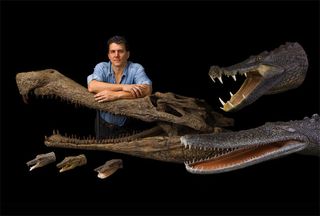Strange Ancient Crocodiles Swam the Sahara

From a crocodile sporting a boar-like snout to a peculiar pal with buckteeth for digging up grub, an odd-looking bunch of such reptiles dashed and swam across what is now the Sahara Desert some 100 million years ago when dinosaurs ruled.
That's the picture created by remains of three newly identified species of ancient crocs plus fossils from two species previously named.
A team led by Paul Sereno of the University of Chicago unearthed remains of the bizarre crocodiles during a series of expeditions beginning in 2000 in the Sahara.
Examination of the remains provides insights into some of the keys to such crocodiles' success, including the ability to walk upright with legs underneath their body while on land and when in the water taking on fish-like abilities.
"We were surprised to find so many species from the same time in the same place," said study researcher Hans Larsson, a paleontologist at McGill University in Montreal. "Each of the crocs apparently had different diets, different behaviors. It appears they had divided up the ecosystem, each species taking advantage of it in its own way."
Three newly identified species:
- Kaprosuchus saharicus: This croc species was about 20 feet long (6 m) and moved about with its arms and legs beneath its body rather than to the sides. Nicknamed BoarCroc, this meat-eater sported an armored snout for ramming along with three sets of dagger-shaped fangs for slicing. It lived in what is now Niger.
- Araripesuchus rattoides: Remains of this crocodile species, dubbed RatCroc, were found in Morocco. The plant- and grub-eater spanned just 3 feet (nearly a meter) in length and its lower jaw was equipped with a pair of buckteeth likely used to dig for food.
- Laganosuchus thaumastos: This 20-foot-long (6 m) crocodile was identified from fossils found in Niger and Morocco. Called PancakeCroc due to its 3-foot-long (1 m) pancake-flat head, the beast had spike-shaped teeth lining its slender jaws. When alive, the predator likely rested for hours, its jaws open and ready to snag a meal.
New fossils of two previously identified crocodile species were also unearthed, including Anatosuchus minor (dubbed DuckCroc), a small crocodile with an overhanging snout tipped with sensory areas that allowed the animal to root around for prey.
Sign up for the Live Science daily newsletter now
Get the world’s most fascinating discoveries delivered straight to your inbox.
And Araripesuchus wegeneri, which was nicknamed DogCroc, sported a doglike nose and likely fed on plants and grubs.
Croc locomotion
To figure out how the ancient creatures got around, Sereno watched captured freshwater crocodiles in northern Australia, finding they could gallop at full speed on land and at the water's edge, dive in and swim like fish.
In light of the observations, Sereno examined the fossils, suggesting these animals also had such land and water talents. The more agile of the bunch evolved a swimming tail, he found.
The team CT-scans the skulls of the two previously named species, DogCroc and DuckCroc, finding they had broad, spade-shaped forebrains that looked different from those of living crocodiles.
"They may have had slightly more sophisticated brain function than living crocs," Larsson said, "because active hunting on land usually requires more brain power than merely waiting for prey to show up."
The findings will be detailed in the journal ZooKeys.
- Top 10 Scariest Sea Creatures
- Video - Hot Crocodile Problem
- Reptiles: News, Information & Images
Most Popular

